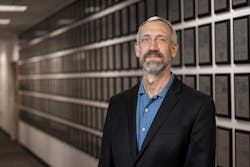As a member of the Peace Corps years ago, Peter de Groot gained an interesting perspective on volunteerism and international development as a physics and chemistry teacher in West Africa.
“I’ve lived the experience of being someplace where opportunities are severely limited for really smart, talented, dedicated people,” he says. An applied research scientist who is chief scientist at Zygo Corp., de Groot has carried those Peace Corps experiences throughout his career.
This includes his now-longtime volunteering involvement with SPIE as a Society Fellow and member of the board of directors, as well as a member of the financial advisory, symposia, and strategic planning committees; a conference chair; and an editorial board member for SPIE’s Optical Engineering journal. And soon, he will take on new roles for this international society for optics and photonics after being elected to its presidential chain. He will first serve as vice president in 2023 before stepping into the president-elect role in 2024, and president in 2025.
“I’m excited about all of the opportunities involved,” de Groot says. “And it starts with being able to work closer with scientists and engineers, the SPIE volunteer governance, and the professional staff. These folks are world-class, dedicated, highly accomplished people. SPIE is a superbly run organization and provides a key component to the professional lives of tens of thousands of engineers and scientists worldwide.”
de Groot embarks on the opportunity with enthusiasm, but realizes this will be a different career experience. After all, the goals are different. “I’ve spent most of my career at Zygo inventing optical instruments to solve a customer problem. That’s been the focus of my thinking for quite a while as an applied research scientist,” he says. “A non-profit professional society like SPIE has aspirations of its own. The goal is to help members to advance their careers, facilitate networking, encourage innovation in optics and photonics, support the science and technology community, and address a constellation of issues that aren’t necessarily part of the everyday life of a scientist. That’s very interesting to me. I’m excited about this!”
As vice president, de Groot says there will be a steep learning curve regarding governance at the executive level. “Although I’ve served on the board as a member and advisor for four years, there is still a lot to learn,” he says.
After serving as vice president in 2023 and president elect in 2024, de Groot will advance to the most visible role as president in 2025. In addition to working with leadership in advancing the strategic plan, the president attends all of SPIE’s major conferences, visits companies and student chapters worldwide, presides over board meetings, and promotes the interests of the society and its membership.
“My personal goals are very much aligned with those of the board of directors and the executive committee,” he says, citing membership expansion, providing high-quality technical meetings, and serving the community through targeted grants, awards, and educational outreach.
Other goals—promoting equity, diversity and inclusion, and strengthening SPIE’s publications offerings—are front of mind for the organization, as well. de Groot adds that the overarching priority for him and for SPIE is to meet the needs of members and the broader photonics and optics community in the most effective ways possible, now and into the future.
“The two-year health crisis, during which most in-person meetings were shut down, forced us to think critically and clearly about one of the primary purposes of SPIE, which is to host international conferences for sharing scientific and engineering knowledge between members,” he says.
The organization considered shifting permanently to a virtual or hybrid conference model, but learned that it wasn’t the best to way serve its members.
“The data and feedback clearly showed that members overwhelmingly prefer to have in-person events. This is no more acutely felt than by our members in industry, who rely on live trade shows to market their innovations,” he says. “One of my hopes is that we find the optimum, environmentally responsible balance between traditional in-person events and the promise of virtual meetings on a global scale. We want to make the society truly international, overcoming geographical, cultural, linguistic, and economic hurdles to global inclusion.”
An excellent example of global community engagement is the SHARE program.
“For many of us, taking part actively in conference attendance and scientific publishing is not a large economic hurdle. But for most of the world, it’s an obstacle,” he says. “Scientists, engineers, and students who are unable to attend in-person meetings or access subscription data services would still like to participate in some way.”
In 2020, SPIE identified portions of the world’s photonics and optics community that were unable to readily access the expansive SPIE Digital Library, which features more than 500,000 publications, recorded conference presentations, and posters. The SHARE program now provides free access to that library in 115 countries that are building research capacity and infrastructure.
“The Digital Library participation in those areas went up 50-fold when the SHARE program was created, so you realize that people want to participate,” de Groot says. “They want to be part of this professional society. They want to be engaged. They want to read the papers and to view SPIE’s expanding collection of over 40,000 video recordings of conference presentations.”
He adds, “there never has been a more exciting time to be in optics and photonics, nor a more challenging time for SPIE to adapt to a rapidly changing professional environment. I am looking forward to working with the exceptional people at SPIE to realize the aspirations of our members.”

Justine Murphy | Multimedia Director, Digital Infrastructure
Justine Murphy is the multimedia director for Endeavor Business Media's Digital Infrastructure Group. She is a multiple award-winning writer and editor with more 20 years of experience in newspaper publishing as well as public relations, marketing, and communications. For nearly 10 years, she has covered all facets of the optics and photonics industry as an editor, writer, web news anchor, and podcast host for an internationally reaching magazine publishing company. Her work has earned accolades from the New England Press Association as well as the SIIA/Jesse H. Neal Awards. She received a B.A. from the Massachusetts College of Liberal Arts.
